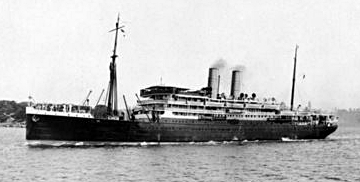RIKUGUN YUSOSEN
 (INDARRA (later HORAI MARU), prewar)
(INDARRA (later HORAI MARU), prewar)
IJA HORAI MARU:
Tabular Record of Movement
© 2018 Bob Hackett
E 1911:
Dumbarton, Scotland, Laid down by Denny W. & Bros. Ltd., shipyard as Yard No. 966, a 9,206-ton passenger ship for the Australasian United Steam Navigation Co., Sydney. Australia.
E 1912:
Launched and named INDARRA.
1912:
Completed.
1920:
Sold to Cie. Maritime Belge (CMB) - Lloyd Royal Belge (Great Britain), Ltd., London. Renamed PAYS DE WAES.
1923:
Repossessed for a short time by Australasian United Steam Navigation Co., Ltd.
Later this year, sold to Osaka Shosen K. K. (OSK Line), Osaka. Renamed HORAI MARU.
7 July 1937: The "First China Incident" and the Beginning of the Second Sino-Japanese War:
Hun River, Lukuokiao, China. Imperial Japanese Army (IJA) troops on night maneuvers at the Marco Polo Bridge fire blank cartridges. Chinese troops across the river think they are under attack. They fire live round back, but do not cause injuries. At morning roll call, the Japanese
discover a soldier missing and assume the Chinese have captured him. The Japanese demand entry to the Peiping (Beijing) suburb of Wanping to look for the soldier, but the Chinese refuse. The Japanese then shell the city. An undeclared war on China begins.
1937:
Chartered by the Imperial Japanese Army (IJA).
3 November 1937:
HORAI MARU departs Goto Islands in the second part of a convoy transporting elements of the 114th Division. The convoy's second part also consists of transports BEIJING, FUSHIMI, JUYO, KARAFUTO, MEIKO, SHINYO, KURETAKE, SHINSEI, TAIAN and YAMATO MARUs escorted by destroyer MIKAZUKI.
5 November 1937:
Arrives at Hangzhou Bay, China.
10 November 1937:
Troops are disembarked.
28 November 1941:
Requisitioned by the IJA. Allotted Army No. 594.
28 February 1942: The Battle of the Sunda Strait:
Bantam Bay. 27 transports land the main body of the IJA's 2nd Infantry Division. At about 2215, American Captain Albert H. Rooks USS HOUSTON (CA-30) and Australian Captain Hector M. L. Waller’s light cruiser HMAS PERTH, sortie for Tjilatjap via the Sunda Strait, but by chance encounter Ozawa’s Western Java Seizure Force transports screened only by DesDiv 5's HARUKAZE, HATAKAZE, DesDiv 11's FUBUKI and MineSweepDiv 1's minesweepers W-1, W-2, W-3 and W-4.
At 2215, HOUSTON and PERTH attack the Japanese troop transports screened only by destroyers HARUKAZE, HATAKAZE and FUBUKI. The destroyers make smoke to mask the transports. FUBUKI charges and launches a salvo of nine torpedoes at HOUSTON and PERTH.
At 2300, the Western Support Force's MIKUMA and MOGAMI, destroyer SHIKINAMI, Third Escort Force's light cruiser NATORI and destroyers SHIRAKUMO, MURAKUMO, SHIRAYUKI, HATSUYUKI and ASAKAZE arrive and engage HOUSTON and PERTH with gunfire and torpedoes.
The Japanese force fires about 90 torpedoes in the engagement. Post-battle analyses indicate that MOGAMI's and FUBUKI's torpedoes probably sank or disabled minesweeper W-2 and transports SAKURA MARU, HORAI MARU, TATSUNO MARU and the Commander-in-Chief of the invading 16th Army LtGen Imamura Hitoshi's transport RYUJO MARU. Imamura jumps into the sea, but survives. The other transports carrying MajGen Nasu Yumio’s detachment of LtGen Maruyama Masao’s 2nd Infantry Division commence landing their troops at Merak, Java.
At 2308, Japanese torpedoes strike both HOUSTON and PERTH. At 2342, PERTH sinks at 05-51-42S, 106-07-52E.
1 March 1942:
At 0036, HOUSTON sinks at 05-48-45S, 106-07-55E.
Author's Note:
Thanks go to Erich Muehlthaler of Germany.
Bob Hackett
Back to
IJA Transports





